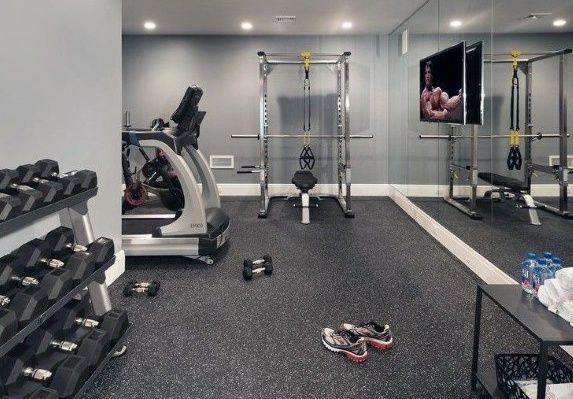Creating a safe, durable, and performance-oriented fitness space starts from the ground up—literally. The type of gym flooring you choose plays a crucial role in workout safety, equipment longevity, and overall gym aesthetics. Whether you’re building a commercial gym, outfitting a home workout area, or renovating an existing fitness studio, selecting the right flooring ensures optimal functionality and performance.
In this guide, we’ll explore the top gym flooring solutions and help you determine which option best suits your fitness environment.
Why Gym Flooring Matters
Choosing the best flooring for your gym isn’t just about looks. The right flooring solution:
- Absorbs impact and reduces joint strain
- Minimizes noise and vibration
- Protects subfloors from heavy equipment
- Offers traction and slip-resistance
- Enhances workout performance and safety
With that in mind, let’s look at the top flooring options available today.
1. Rubber Gym Flooring
Best For: Commercial gyms, weight rooms, home gyms, functional training zones
Why It’s Great:
Rubber is one of the most popular choices for gym flooring—and for good reason. It’s durable, shock-absorbent, and versatile. It can withstand dropped weights, high foot traffic, and constant movement.
Types of Rubber Flooring:
- Rubber Rolls: Ideal for covering large areas seamlessly.
- Rubber Tiles: Easy to install and replace; great for DIY setups.
- Rubber Mats: Perfect for smaller zones or temporary setups.
Pros:
- Excellent shock absorption
- Slip-resistant surface
- Easy to clean and maintain
- Long-lasting and eco-friendly (recycled options available)
Cons:
- Can be heavy to install
- Slight rubber odor initially
SEO Keywords: rubber gym flooring, commercial gym rubber mats, gym floor tiles
2. Foam Flooring
Best For: Home gyms, yoga studios, light cardio spaces
Why It’s Great:
Foam tiles are soft, lightweight, and budget-friendly. They offer excellent cushioning for bodyweight exercises, stretching, and low-impact workouts.
Ideal For:
- Kids’ fitness areas
- Stretching zones
- Pilates or yoga studios
Pros:
- Affordable and easy to install
- Comfortable surface for floor work
- Available in various colors and designs
Cons:
- Not suitable for heavy weights or high-impact training
- Can dent or tear under pressure
SEO Keywords: foam gym floor tiles, best flooring for home gym, yoga studio flooring
3. Vinyl Flooring
Best For: Group fitness studios, aerobic zones, multipurpose rooms
Why It’s Great:
Vinyl flooring is water-resistant, low-maintenance, and available in a variety of textures and finishes. It offers a smooth, clean surface perfect for aerobic exercises and studio classes.
Popular in:
- Dance fitness classes
- Zumba and aerobics rooms
- Wellness and stretching areas
Pros:
- Water and sweat-resistant
- Easy to clean
- Sleek and professional appearance
Cons:
- Less shock absorption than rubber
- Not ideal for heavy lifting areas
SEO Keywords: vinyl gym flooring, aerobic studio flooring, waterproof gym floor
4. Turf Flooring
Best For: CrossFit gyms, functional fitness spaces, agility training zones
Why It’s Great:
Artificial turf brings outdoor functionality into indoor training environments. It’s ideal for sled pushes, tire flips, and agility drills.
Often used in:
- Sports performance centers
- Bootcamp-style gyms
- Sprint lanes
Pros:
- Durable and high-performance surface
- Provides traction and cushioning
- Great for sleds and footwork training
Cons:
- Requires more maintenance than rubber
- Higher upfront cost
SEO Keywords: indoor turf gym flooring, CrossFit turf, gym agility turf
5. Carpet Tiles
Best For: Corporate fitness centers, low-impact cardio zones
Why It’s Great:
Carpet tiles offer a soft surface with decent traction. They're used in environments where comfort and noise reduction are top priorities.
Common in:
- Corporate or hotel gyms
- Fitness lounges
- Stretching and warm-up areas
Pros:
- Sound-absorbing
- Easy to replace individual tiles
- Comfortable underfoot
Cons:
- Stains easily
- Not suitable for heavy equipment or moisture-prone areas
SEO Keywords: carpet tiles for gym, commercial gym carpet, gym flooring noise reduction
6. Hardwood Flooring
Best For: Basketball courts, dance studios, upscale fitness centers
Why It’s Great:
Hardwood floors are visually striking and provide an ideal surface for dynamic, rhythmic movement. They're most common in sports courts and premium fitness centers.
Pros:
- Classic, elegant appearance
- Great for group classes and indoor sports
- Durable if maintained properly
Cons:
- Expensive and high-maintenance
- Slippery when wet
- Not suitable for weightlifting areas
SEO Keywords: hardwood gym flooring, premium gym floors, dance studio wood floors
Installation and Maintenance Tips
- Professional Installation: Always recommended for commercial spaces to ensure seamless, safe flooring.
- Daily Cleaning: Use non-abrasive cleaners and mops to maintain hygiene.
- Check Compatibility: Ensure your flooring matches the type of workouts and equipment you’ll use.
- Replace When Worn: Damaged or dented flooring can become a hazard and should be replaced promptly.
SEO Keywords: gym floor maintenance, how to clean gym flooring, gym floor replacement tips
Final Thoughts
Choosing the right gym flooring solution is one of the most important investments in your fitness space. It impacts everything from safety and comfort to equipment durability and user satisfaction.
Whether you’re setting up a home gym, commercial facility, or specialized training studio, your choice should reflect your training style, foot traffic, and budget. From rugged rubber mats to sleek vinyl surfaces and artificial turf, the options are as versatile as your workouts.
